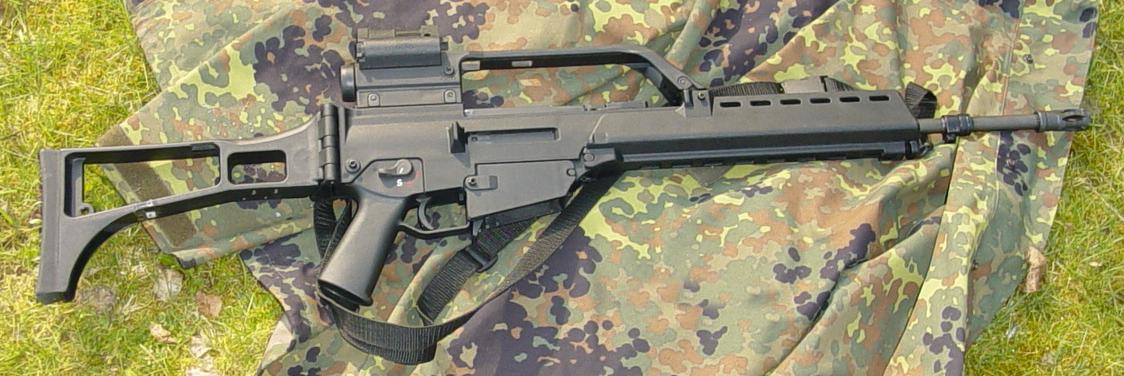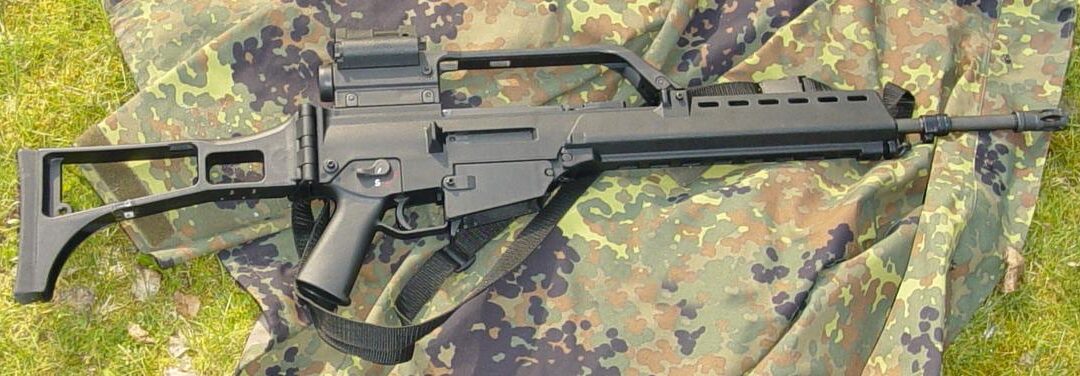Heckler & Koch’s G 36 (the HK G36) rifle was designed back in the early ‘90s as a more lightweight alternative to 7.62 mm G3 battle rifle. It was accepted into service seven years later, when the German Bundeswehr replaced their G3 with this gas-operated beauty. This 5.56 x 45mm assault rifle has been named the modern equivalent of the Albrecht Durer due to a number of attractive features.
Of course, this particular firearm is definitely large and that may be discouraging to some. Heckler & Koch later developed a shorter version of the HK G36 and dubbed it the G36C (the “C” stands for “carbine version”). So let’s go over the design and specifications of both the classic HK G36 and its shorter counterpart.

HK G36 and G36C Design Details and Specifications
Type: Assault Rifle
Designed in: Germany
Manufacturer: Heckler & Koch
Weight: 8.00 lb (G36); 6.2 lb (G36C)
Length: 39.3 inches (G36); 28.3 inches (6.36C)
Caliber: 5.56
Action: Rotating bolt, short-stroke piston
Effective Firing Range: 800 m
Both the G36 and the G36C are selective-fire assault rifles that fire from a closed rotary bolt. Their conventional layout and modular component design have made these firearms popular in over 40 countries, including Belgium (used by the Antwerp local police), Canada (Victoria PD), Denmark, France, Finland, Germany, Sweden, the U.S., and many more.
The magazine holds 30 cartridges (approximately 400-450 rounds) and is high-cap, wind-up. One particularly great feature with the HK G36 is its fully ambidextrous magazine release and fire control (making it an excellent choice for lefties). The rifle also features a folding stock and adjustable rear sights (a standard ZF 3×4 dual optical sight combined with a 3x magnified telescopic sight).
As for the material, the G36 and the G36c both employ lightweight, corrosion-resistant materials: carbon fiber-reinforced polyamide is used for the handguard, the magazine well, the trigger, receiver housing, and stock, while the receiver features a steel barrel trunnion.
Aside from the fully ambidextrous controls (the G36’s charging handle is fixed to the bold, so that it can move back and forth underneath the rail along the top of the receiver- it’s easy to grab by soldiers but protected from ropes and other environmental items that may hinder the use of the gun), there are also other massive benefits to the G36 rifle.
This assault rifle is close to a pound lighter than other rifles in its category, making it exceptionally easy to handle. The H&K G36 also sports a feature that allows shooters to tie multiple magazines together. That’s because the G36’s magazines use a set of nubs that slide into each other.
For the G36c, H&K shortened the barrel drastically and repositioned the gas block so that the gun can keep on cycling even with the shorter dwell time inside the barre.
G36 Rifle Accuracy, Ergonomics, and Drawbacks
For a short-barreled 5.56 assault rifle, the G36c performs averagely. For one, the distance between the top of the G36C’s barrel and the center of the sights is almost 3 inches (when the standard is approximately one and a half inches). As a general rule of thumb, a rifle is that much more comfortable to use (and more accurate) the closer your top of the barrel is to your sights. With the G36C, you’ll going to have to improvise. What’s more, despite having been shortened, the G36C is just as tall as the G36, making it look far from sleek.
The lightweight materials used to manufacture the rifle and the short barrel also work together towards another problem: the rifle has trouble soaking up recoil. In the end, most of the gun’s recoil is transmitted back to the shooter) and while single shots should cause no trouble, even the most experienced of shooters will have problems keeping the rifle on target in full auto mode.
There are also additional accuracy concerns with the G36C, particularly as a result of overheating. Back in 2012, reports suggested that the rifle’s accuracy would severely suffer in prolonged firefight conditions. In fact, the G36 has been reported to have difficulties hitting targets past 100 meters (other reports showed that the rifle was incapable of accurate fire past 300 meters). Last year, the Bundeswehr finally announced that they were no longer going to use the HK G36.
For those who are accustomed to US-produced magazines, the way that G36c magazines perform will feel rather odd. That’s because they still employ the old AK-47 release (the one that uses a tab that holds the magazine in its place), making the process slow and awkward.
Where ergonomics are concerned, the HK G36C is peculiar to say the least. That’s because of its shorter barrel and the way that it was redesigned. It’s chunky and odd to maneuver, especially at first.
The G36C is an average gun, with certain attractive features that make it interesting to gun enthusiasts. Even so, its mechanics definitely leave place for improvement, and with newer models being designed in the following years, it’s clear that the G36C will continue to lose its appeal as time goes by.

